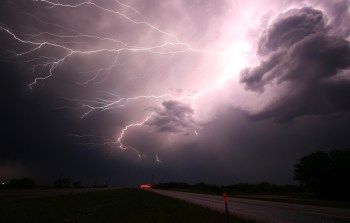
Climate Change Dispatch Ross McKitrick | June 7, 2019
This week in Vancouver, Prime Minister Trudeau said the federal carbon tax, a key pillar in his government’s climate policy, will help protect Canadians from extreme weather.
“Extreme weather events are extraordinarily expensive for Canadians, our communities and our economy,” he said, citing the recent tornadoes in Ottawa and wildfires in Western Canada. “That’s why we need to act.”
While members of the media may nod along to such claims, the evidence paints a different story.
Roger Pielke Jr. is a scientist at the University of Colorado in Boulder who, up until a few years ago, did world-leading research on climate change and extreme weather.
He found convincing evidence that climate change was not leading to higher rates of weather-related damages worldwide, once you correct for increasing population and wealth.
He also helped convene major academic panels to survey the evidence and communicate the near-unanimous scientific consensus on this topic to policymakers.
For his efforts, Pielke was subjected to a vicious, well-funded smear campaign backed by, among others, the Obama White House and leading Democratic congressmen, culminating in his decision in 2015 to quit the field.
A year ago, Pielke told the story to an audience at the University of Minnesota. His presentation was recently circulated on Twitter. With so much misinformation nowadays about supposed climate emergencies, it’s worth reviewing carefully.
Pielke’s public presentation begins with a recounting of his rise and fall in the field.
As a young researcher in tropical storms and climate-related damages, he reached the pinnacle of the academic community and helped organize the so-called Hohenkammer Consensus Statement, named after the German town where 32 of the leading scientists in the field gathered in 2006 to sort out the evidence.
They concluded that trends toward rising climate damages were mainly due to increased population and economic activity in the path of storms, that it was not currently possible to determine the portion of damages attributable to greenhouse gases, and that they didn’t expect that situation to change in the near future.
Shortly thereafter, the Intergovernmental Panel on Climate Change (IPCC) released its 2007 report, largely agreeing with the Hohenkammer Consensus, while cherry-picking one unpublished study (and highlighting it in the Summary for Policymakers) that suggested a link between greenhouse gases and storm-related damages.
But the author of that study — who just happened to be the same IPCC lead author who injected it into the report — later admitted his claim was incorrect, and when the study was finally published, denied the connection.
In 2012, the IPCC Special Report on Extreme Weather came out and echoed the Hohenkammer Consensus, concluding that once you adjust for population growth and economic changes, there is no statistical connection between climate change and measures of weather-related damages.
In 2013, Pielke testified to the United States Congress and relayed the IPCC findings.
Shortly thereafter, Obama’s science advisor John Holdren accused him of misleading Congress and launched a lengthy but ill-informed attack on Pielke, which prompted congressional Democrats to open an investigation into Pielke’s sources of funding (which quickly fizzled amid benign conclusions).
Meanwhile, heavily funded left-wing groups succeeded in getting him fired from a popular internet news platform. In 2015 Pielke quit the climate field.
So where did the science end up?
In the second half of his talk, Pielke reviews the science as found in the most recent (2013) IPCC Assessment Report, the 2018 U.S. National Climate Assessment, and the most up-to-date scientific data and literature. Nothing substantial has changed.
Globally there’s no clear evidence of trends and patterns in extreme events such as droughts, hurricanes, and floods. Some regions experience more, some less and some no trend.
Limitations of data and inconsistencies in patterns prevent confident claims about global trends one way or another. There’s no trend in U.S. hurricane landfall frequency or intensity.
If anything, the past 50 years has been relatively quiet. There’s no trend in hurricane-related flooding in the U.S. Nor is there evidence of an increase in floods globally.
Since 1965, more parts of the U.S. have seen a decrease in flooding than have seen an increase. And from 1940 to today, flood damage as a percentage of GDP has fallen to less than 0.05 percent per year from about 0.2 percent.
And on it goes. There’s no trend in U.S. tornado damage (in fact, 2012 to 2017 was below average). There’s no trend in global droughts. Cold snaps in the U.S. are down but, unexpectedly, so are heatwaves.
The bottom line is there’s no solid connection between climate change and the major indicators of extreme weather, despite Trudeau’s claims to the contrary.
The continual claim of such a link is misinformation employed for political and rhetorical purposes. Powerful people get away with it because so few people know what the numbers show.
Many scientists who know better remain silent. And the few who push back against the propaganda, such as Roger Pielke Jr., find themselves on the receiving end of abuse and career-threatening attacks, even though they have all the science in their corner.
Something has gotten scary and extreme, but it isn’t the weather.


